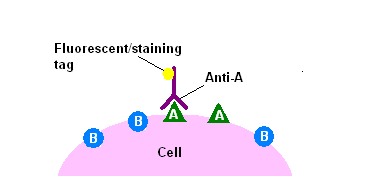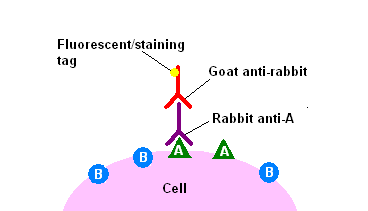Immunohistochemistry
Editor-In-Chief: C. Michael Gibson, M.S., M.D. [1]
Immunohistochemistry or IHC refers to the process of localizing proteins in cells of a tissue section exploiting the principle of antibodies binding specifically to antigens in biological tissues. [1] It takes its name from the roots "immuno," in reference to antibodies used in the procedure, and "histo," meaning tissue. Immunohistochemical staining is widely used in the diagnosis and treatment of cancer. Specific molecular markers are characteristic of particular cancer types. IHC is also widely used in basic research to understand the distribution and localization of biomarkers in different parts of a tissue.
Visualising an antibody-antigen interaction can be accomplished in a number of ways. In the most common instance, an antibody is conjugated to an enzyme, such as peroxidase, that can catalyse a colour-producing reaction (see immunoperoxidase staining). Alternatively, the antibody can also be tagged to a fluorophore, such as FITC, rhodamine, or Texas Red, (see immunofluorescence). The latter method is of great use in confocal laser scanning microscopy, which is highly sensitive and can also be used to visualise interactions between multiple proteins.
Antibody types
The antibodies used for specific detection can be polyclonal or monoclonal. Monoclonal antibodies are generally considered to exhibit greater specificity. Polyclonal antibodies are made by injecting animals with peptide antigens, and then after a secondary immune response is stimulated, isolating antibodies from whole serum. Thus, polyclonal antibodies are a heterogeneous mix of antibodies that recognize several epitopes.
Antibodies can also be classified as primary or secondary reagents. Primary antibodies are raised against an antigen of interest and are typically unconjugated (unlabelled), while secondary antibodies are raised against primary antibodies. Hence, secondary antibodies recognize immunoglobulins of a particular species and are conjugated to either biotin or a reporter enzyme such as alkaline phosphatase or horseradish peroxidase. Some secondary antibodies are conjugated to fluorescent agents, such as the Alexa-Fluor family, are also frequently used for detection of proteins in IHC procedures. Protein concentration is generally measured by densitometry analysis, where the intensity of staining correlates with the amount of the protein of interest.
Sample preparation
In the procedure, depending on the purpose and the thickness of the experimental sample, either thin (about 4-40 μm) slices are taken of the tissue of interest, or if the tissue is not very thick and is penetrable it is used whole. The slicing is usually accomplished through the use of a microtome, and slices are mounted on slides. "Free-floating IHC" uses slices that are not mounted, these slices are normally produced using a vibrating microtome.
Direct and indirect IHC

There are two strategies used for the immmunohistochemical detection of antigens in tissue, the direct method and the indirect method.In both cases, the tissue is treated to rupture the membranes, usually by using a kind of detergent called Triton X-100.
The direct method is a one-step staining method, and involves a labeled antibody (e.g. FITC conjugated antiserum) reacting directly with the antigen in tissue sections. This technique utilizes only one antibody and the procedure is therefore simple and rapid. However, it can suffer problems with sensitivity due to little signal amplification and is in less common use than indirect methods.

The indirect method involves an unlabeled primary antibody (first layer) which reacts with tissue antigen, and a labeled secondary antibody (second layer) which reacts with the primary antibody. (The secondary antibody must be against the IgG of the animal species in which the primary antibody has been raised.) This method is more sensitive due to signal amplification through several secondary antibody reactions with different antigenic sites on the primary antibody. The second layer antibody can be labeled with a fluorescent dye or an enzyme.
In a common procedure, a biotinylated secondary antibody is coupled with streptavidin-horseradish peroxidase. This is reacted with 3,3'-Diaminobenzidine (DAB) to produce a brown staining wherever primary and secondary antibodies are attached in a process known as DAB staining. The reaction can be enhanced using nickel, producing a deep purple/gray staining.
The indirect method, aside from its greater sensitivity, also has the advantage that only a relatively small number of standard conjugated (labeled) secondary antibodies needs to be generated. For example, a labeled secondary antibody raised against rabbit IgG, which can be purchased "off the shelf," is useful with any primary antibody raised in rabbit. With the direct method, it would be necessary to make custom labeled antibodies against every antigen of interest.
Diagnostic IHC markers
IHC is an excellent detection technique and has the tremendous advantage of being able to show exactly where a given protein is located within the tissue examined. This has made it a widely-used technique in the neurosciences, enabling researchers to examine protein expression within specific brain structures. Its major disadvantage is that, unlike immunoblotting techniques where staining is checked against a molecular weight ladder, it is impossible to show in IHC that the staining corresponds with the protein of interest. For this reason, primary antibodies must be well-validated in a Western Blot or similar procedure. The technique is even more widely used in diagnostic surgical pathology for typing tumors (e.g. carcinoma vs melanoma).
- Carcinoembryonic antigen (CEA): used for identification of Adenocarcinomas. Not specific for site.
- CD15 and CD30 : used for Hodgkin's disease
- Alpha fetoprotein: for yolk sac tumors and hepatocellular carcinoma
- CD117: for gastrointestinal stromal tumors (GIST)
- Prostate specific antigen (PSA): for prostate cancer
- estrogens and progesterone staining for tumour identification
- Identification of B-cell lymphomas using CD20
Immunotherapy
Many proteins shown to be highly upregulated in pathological states by immunohistochemistry are potential targets for therapies utilising monoclonal antibodies.
For example, Her-2/neu (also known as Erb-B2) is highly expressed in a variety of cancer cell types. As such, antibodies against Her-2/neu have been FDA approved for clinical treatment of cancer under the drug name Herceptin.
References
- ↑ Ramos-Vara, JA (2005). "Techical Aspects of Immunohistochemistry". Vet Pathol. 42: 405–426.
External links
- Immunohistochemistry Staining Protocols at Immunoportal.com
- Yale Core Tissue Microarray Facility
- Histochemical Staining Methods - University of Rochester Department of Pathology
- Immunohistochemistry Staining Protocol
- HistoWiki entry for Immunohistochemistry
- Burnett R, Guichard Y, Barale E (1997). "Immunohistochemistry for light microscopy in safety evaluation of therapeutic agents: an overview". Toxicology. 119 (1): 83–93. PMID 9129199.
- Immunohistochemistry at the US National Library of Medicine Medical Subject Headings (MeSH)